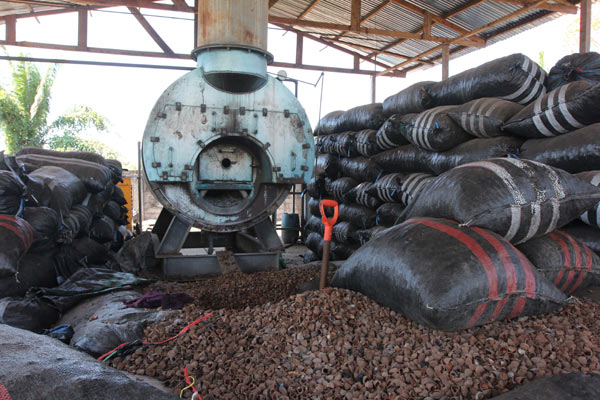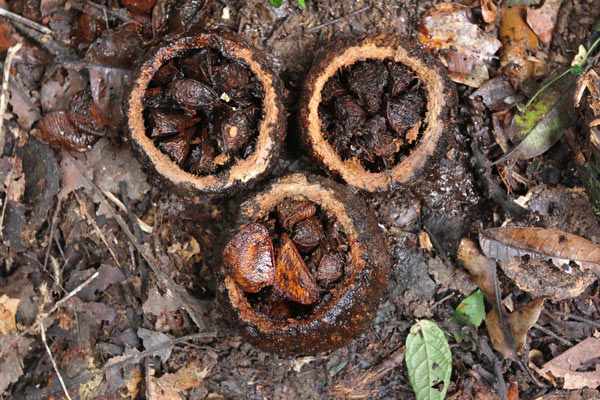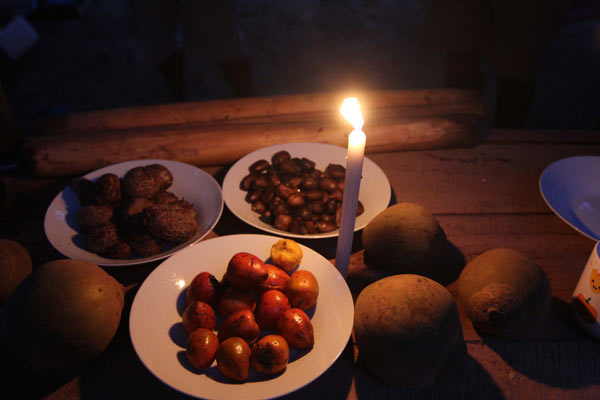This Article was originally published on Mongabay and was written by Barbara Fraser. You can find the original here
Sofía Rubio was eight years old when she decided she wanted to be a biologist. “I would skip school to go to the woods with my father or mother,” who did research in what is now the Tambopata National Reserve in the southeastern Peruvian Amazon, she says.
Today, dressed in a white lab coat, her ponytail caught up under a green hair net, Rubio hovers over a table, weighing Brazil nuts. But she’s not cloning them or studying their genes. She is scooping them up and sealing them in small plastic bags with a brightly colored “Shiwi” logo.
Rubio is a biologist-turned-businesswoman with her roots in the rainforest, and her mind on the market. Her first experiment, half a dozen years ago, was granola, which was taste-tested by friends before she marketed it. Since then, Shiwi , the company she started, has launched a variety of products. From nut chips with garlic to lip balm, all are made with Brazil nuts harvested in the Tambopata reserve.
 Tourist visiting Brazil nut concession in the Tambopata National Reserve displays nuts – actually seeds – inside a pod. Photo by Barbara Fraser. |
Every year, in February and March, nearly 100 families gather Brazil nuts that have fallen to the ground in Tambopata National Reserve. They harvest the nuts in the protected area via concessions granted under the reserve’s multiple-use zoning system. Then they dry them in the sun and haul them upriver to a plant owned by their organization, the Association of Brazil Nut Harvesters of the Tambopata Reserve (ASCART, for its Spanish initials), where the nuts are toasted, cracked open, and sorted for sale.
Rubio is taking this a step further, adding value by processing the nut in ways that are new to harvesters in the Madre de Dios Region of the Peruvian Amazon, and offering it to consumers as a sustainably-harvested product from a flagship park.
She is trying to convince the other ASCART members to follow her lead. If she’s successful, they could profit from the nuts year-round, not just for a couple of months at the beginning of the year. Rubio hopes this could allow more people to avoid turning to destructive employment in the region including logging, bushmeat hunting, or poorly regulated small-scale gold mining.
The result, she says, would be a win-win for the harvesters and the trees.
The Brazil nut is a niche product, even in the forest. It is the fruit of an Amazonian giant, the Brazil nut tree (Bertholletia excels), which can grow more than 100 feet tall and six feet around. The flowers, which bloom for a day, are pollinated by orchid bees, which are strong enough to lift the flower’s hood.
The nuts form in a pod that looks like a cannonball and crashes from the treetop with enough force to seriously injure—or even kill—anyone passing below. That’s not enough to break open the pod, however, so the tree’s reproduction depends on the agouti (Dasyprocta leporine), a medium-sized rodent with the teeth—and patience—to gnaw through the fibrous pod and the tough shells of the nuts. It eats some nuts and stores others by burying them. Forgotten nuts have a chance of sprouting.
The rare trees are scattered over a large area. Rubio calculates that there are only about 700 trees in her mother’s 1,200-hectare concession. Harvesters map the trees and clear trails between them.

Workers shell Brazil nuts at the ASCART plant in Puerto Maldonado, Peru. Photo by Barbara Fraser.

ASCART president Leslie Aguilar oversees the Brazil nut processing plant in Puerto Maldonado, Peru. Photo by Barbara Fraser.
Harvesting the nuts is hard labor, though, and it is no longer easy to find people willing to do it. The Brazil nut industry emerged about a century ago, when the rubber boom went bust, but has been overtaken in recent years by the gold rush sweeping this corner of the Peruvian Amazon.
Brazil nut workers are paid by the sack, which weighs about 75 kilos. Before the gold rush, harvesters would work for 25 soles a sack – about U.S.$8. Now they demand twice that.
The average worker produces about a sack a day, Rubio said, although a really skillful one might fill three. Rubio’s concession produces about 3,000 kilos of nuts in a season.
Mario Montes is one of the nut harvesters. He has tried his hand at gold mining, but would rather farm. He hires himself and his family out to gather Brazil nuts in February and March, because it’s a handy shot of income at the start of the academic year when the children need shoes and school supplies.

Sacks of Brazil nuts await drying at the ASCART processing plant in Puerto Maldonado, Peru. Photo by Barbara Fraser.

Peru produced 37 million metric tons of Brazil nuts between 2000 and 2010. Photo by Barbara Fraser.
Last year, Montes’ family set up camp in January in the concession managed by Rubio. They began collecting nuts in February, when most of the pods had fallen, and were still working in March, when Rubio arrived with eight tourists eager to try their hand at the harvest. If Montes thought they were crazy to pay to learn about the back-breaking work he has done seasonally for years, he didn’t show it. Instead, he regaled the visitors with tales of his encounters with the chullachaqui, a forest spirit with one human foot and one cloven hoof, ever ready to deceive the unwary hunter and lure him to its lair.
In the morning, Montes taught the tourists how to grip a trident-like wooden tool called a pallana and give it just the right twist to pick up the pod and flip it into a basket on his back.
Once the basket was full, he dumped the pods into a pile and expertly sliced them with a machete, without nicking the nuts inside.

Mario Montes, 58, splits a Brazil nut pod open to empty out the seeds; he will leave the pods to decompose on the forest floor. Photo by Barbara Fraser.

Brazil nuts are found in Brazil, Bolivia and Peru; in Peru, nearly all the trees are in the southeastern Madre de Dios region. Photo by Barbara Fraser.
One by one the visitors tried their hand, strapping the basket to their backs and awkwardly wielding the pallana. They sometimes missed the basket, sending the pods skittering into the undergrowth. But most left the machete whacks to Montes. The tourists worked up an appetite, though, and back at the camp, while taking shelter from a sudden downpour, they eagerly sampled nuts and some of the region’s native fruits.
Much like herbed Brazil nut chips and Nutella-like chocolate-Brazil nut spread, this experiential tourism is another of Rubio’s inventions, and she’ll be experimenting with it again in March.
Although she needed special permission from park managers, because the Brazil nut concessions are not zoned for tourism, she sees it as another low-impact activity to create jobs and increase harvesters’ income, making them less likely to seek work in more destructive activities.
 Harvesters use a handmade wooden tool called a pallana to pick up the Brazil nut pods and flip them into a backpack-style basket. Photo by Barbara Fraser. |
“Madre de Dios has mining, logging, farming, ranching, a little fishing or fish farming, tourism, commerce and Brazil nuts,” Rubio says, succinctly summing up the Amazonian region’s economy. “And of all of those, the ones that are good for the forest are tourism and Brazil nuts. So how can we combine those good ones in a winning formula?”
For her, the answer is “that people go to the forest, and that they not only see trees and animals and have a nature experience, but they see it reflected in everyday life, and they think, ‘Hey, what I eat has an impact in this place, and I’m feeling it in this place right now.'”
That “this place” is the Tambopata National Reserve comes with both advantages and disadvantages, Rubio says. On the plus side, the trees are protected from the many pressures in the region, even those like gold mining, which has invaded the buffer zone along the Interoceanic Highway to Brazil and occasionally spilled into the protected area itself.
And working in a protected area has other advantages: it has made organic certification fairly easy. Peru’s Environment Ministry also certifies the nuts as coming from a sustainably managed area.
The major disadvantage, Rubio says, is that all the work must be done manually. That can mean carrying baskets weighing 60 or 70 kilos for hours through the heat, rain, and mud. In Brazil nut concessions outside of the reserve, harvesters use motorcycles, making the work much easier, although Rubio, as a biologist, also acknowledges the down side of this—frightening the wildlife away and spewing pollution.
 At the end of the day, a harvester may haul more than 60 kilos of Brazil nuts out of the forest on his back. Photo by Barbara Fraser. |
Still, Brazil nut concessions outside the reserve are vulnerable to invasion by gold miners and loggers operating illegally. Even deforestation around them, for mining or agriculture, can lower the trees’ production.
Encroachment by these activities is a threat in Madre de Dios, as there are more than 80,000 hectares of land where mining or farming rights overlap with Brazil nut concessions. These overlapping uses are the legacy of a system in which each government ministry granted land-use rights without coordinating with others, according to a 2012 study by the Center for International Forestry Research (CIFOR).
Brazil nut and timber concessions overlap on about 1.3 million hectares, but researchers say that is not necessarily a problem, if the timber is managed well.
The ideal might be a private conservation area where the landowner could combine Brazil nut harvesting, some timber management, and ecotourism, according to Rubio.
For now, ASCART is trying to leverage the advantages of harvesting in the Tambopata Reserve along with taking a more businesslike approach to processing and sales, says Leslie Aguilar, the organization’s president.
“The Brazil nut harvesters’ dream was always to get a better price for their product,” he says.
For years, the members sold directly to processors, with each member bargaining individually. Eventually, they realized they could negotiate better terms if they pooled their resources and offered higher volume.

By using the pallana, the harvester avoids reaching under bushes and leaves where there could be snakes or other hazards. Photo by Barbara Fraser.

Shiwi founder Sofía Rubio packages Brazil nut chips that will be sold through organic product markets in Lima. Photo by Barbara Fraser.
With the help of prize money from an entrepreneurship contest sponsored by the Ministry of Agriculture and some assistance from Odebrecht–the construction company that paved the highway that borders part of Tambopata Reserve’s buffer zone–ASCART built its own processing plant on a bluff overlooking the river in Puerto Maldonado. Members can tie up their boats and unload their sacks directly.
On a sunny afternoon in October, Aguilar strolled through the processing room where workers skillfully cracked the rough shells, sackful by sackful, dividing nuts by quality. The plant employs 55 to 60 people during the processing season, generally from April until October or November.
Most of the workers are women from the neighborhood around the plant. They earn about $10 a day for reducing around 60 kilos of nuts in the shell to 20 kilos of shelled nuts.
Last season, they filled an order for a single customer. The going price for Brazil nuts was about $5 per kilo of shelled nuts, but one company purchased all of ASCART’s production for nearly $1 a kilo more, Aguilar says. ASCART expected to sell about 33,000 kilos of nuts to that buyer.
That’s the good news. The bad news is that armed robbers raided the plant in July and stole three metric tons of nuts worth nearly $20,000. The nuts belonged to a third party who had hired ASCART to do the processing. The organization arranged to repay the amount in installments, but it meant postponing other plans.
For Aguilar, having concessions inside the Tambopata reserve is more of an obstacle than an advantage for Brazil nut harvesters. They are not allowed to hunt game or cut trees, he says, while members of a nearby indigenous community are.
On the other hand, ASCART members whose concessions are closer to the highway are affected when farmers burn their fields, he says

Since her first experiments with granola, Shiwi founder Sofía Rubio has developed flavored chips, oils, lip balm and butters made from Brazil nuts. Photo by Barbara Fraser.
Rubio sees the international organic certification and the park service seal of approval as having benefits for all the members, although ASCART is not yet taking advantage of them. She hopes to convince more ASCART members to follow her lead and begin adding value to their Brazil nuts, rather than just selling the plain nuts. That way ASCART could sell to customers like hers, such as restaurants and organic product shops in Lima. She is also talking with them about organizing a joint venture to take advantage of the market for Brazil nut products.
Ever the scientist, Rubio continues to test her business hypotheses: that processing the nuts into value-added product will create jobs, increase income, and spread the revenues out over the year, making people less likely to go into more destructive lines of work; that having a strong local market provides a buffer against shocks; and that adding value to the product will help people appreciate Brazil nut trees more.
And although she recalls the early years of going to product fairs and “doing more talking than selling,” Rubio says her sales have doubled each year, boding well for ASCART if it makes the jump.
“It’s a completely new product,” she says of each of her innovations—the nut butter, nut chips, oil, granola and other products. “You have to test it, demonstrate it, so the market becomes familiar with it. But once people know about it, that translates immediately into sales.”
Read more: http://news.mongabay.com/2015/0211-sri-fraser-brazil-nuts.html#ixzz3Ur3bjtIo



Toasting nuts enhances their floavr. Since nuts are high in fat, they can scorch easily. Always toast nuts in a shallow container in a single layer. A low to moderate oven (300b0 to 325b0F) is best. The nuts are done when you can smell their aroma and they’ve become golden brown. Remove them from the oven when their color is just a shade lighter than what you’re looking for, as they’ll continue to cook a bit as they cool. Once the nuts are done, remove them from the oven and transfer them to a cool surface immediately, to minimize this carry-over cooking. If you’re toasting sweetened coconut, remove it from the oven and stir it on the baking pan every five minutes to ensure even browning.
Dear sir.
this is kevin from korea
This is import company .
I want brazil nut and cacao nibs.
if your company want export to korea
let me know.
minimum order
price (without shell).
as soon as possible.
kevin
best regards